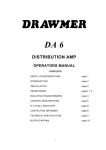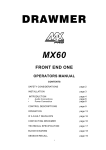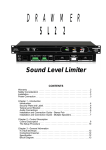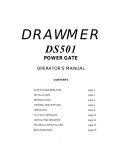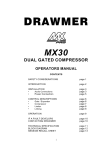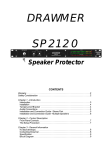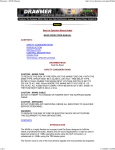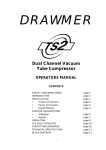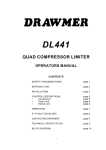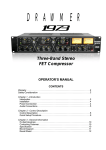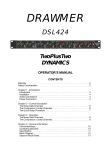Download Drawmer MX50 Specifications
Transcript
DRAWMER MX50 DUAL DE-ESSER OPERATORS MANUAL CONTENTS SAFETY CONSIDERATIONS page 1 INTRODUCTION page 2 INSTALLATION • Audio Connections • Power Connection page 3 page 3 page 5 CONTROL DESCRIPTIONS and OPERATION • Linking page 6 page 7 IF A FAULT DEVELOPS page 8 CONTACTING DRAWMER page 8 TECHNICAL SPECIFICATION page 9 BLOCK DIAGRAM page 10 SESSION RECALL page 11 i COPYRIGHT This manual is copyrighted © 2011 by Drawmer Electronics, Ltd. With all rights reserved. Under copyright laws, this manual may not be duplicated in whole or in part without the written consent of Drawmer. ONE YEAR LIMITED WARRANTY Drawmer Electronics Ltd., warrants the Drawmer MX50 audio processor to conform substantially to the specifications of this manual for a period of one year from the original date of purchase when used in accordance with the specifications detailed in this manual. In the case of a valid warranty claim, your sole and exclusive remedy and Drawmer’s entire liability under any theory of liability will be to, at Drawmer’s discretion, repair or replace the product without charge, or, if not possible, to refund the purchase price to you. This warranty is not transferable. It applies only to the original purchaser of the product. For warranty service please call your local Drawmer dealer. Alternatively call Drawmer Electronics Ltd. at +44 (0)1709 527574. Then ship the defective product, with transportation and insurance charges pre-paid, to Drawmer Electronics Ltd., Coleman Street, Parkgate, Rotherham, S62 6EL UK. Write the RA number in large letters in a prominent position on the shipping box. Enclose your name, address, telephone number, copy of the original sales invoice and a detailed description of the problem. Drawmer will not accept responsibility for loss or damage during transit. This warranty is void if the product has been damaged by misuse, modification or unauthorised repair. THIS WARRANTY IS IN LIEU OF ALL WARRANTIES, WHETHER ORAL OR WRITTEN, EXPRESSED, IMPLIED OR STATUTORY. DRAWMER MAKES NO OTHER WARRANTY EITHER EXPRESS OR IMPLIED, INCLUDING, WITHOUT LIMITATION, ANY IMPLIED WARRANTIES OF MERCHANTABILITY, FITNESS FOR A PARTICULAR PURPOSE, OR NON-INFRINGEMENT. PURCHASER’S SOLE AND EXCLUSIVE REMEDY UNDER THIS WARRANTY SHALL BE REPAIR OR REPLACEMENT AS SPECIFIED HEREIN. IN NO EVENT WILL DRAWMER ELECTRONICS LTD. BE LIABLE FOR ANY DIRECT, INDIRECT, SPECIAL, INCIDENTAL OR CONSEQUENTIAL DAMAGES RESULTING FROM ANY DEFECT IN THE PRODUCT, INCLUDING LOST PROFITS, DAMAGE TO PROPERTY, AND, TO THE EXTENT PERMITTED BY LAW, DAMAGE FOR PERSONAL INJURY, EVEN IF DRAWMER HAS BEEN ADVISED OF THE POSSIBILITY OF SUCH DAMAGES. Some states and specific countries do not allow the exclusion of implied warranties or limitations on how long an implied warranty may last, so the above limitations may not apply to you. This warranty gives you specific legal rights. You may have additional rights that vary from state to state, and country to country. In the interests of product development, Drawmer reserve the right to modify or improve specifications of this product at any time, without prior notice. ii MX50 OPERATORS’ MANUAL 1 DRAWMER MX50 Dual De-Esser SAFETY CONSIDERATIONS CAUTION - MAINS FUSE TO REDUCE THE RISK OF FIRE REPLACE THE MAINS FUSE ONLY WITH THE SAME TYPE, WHICH MUST BE A CLASS 3, 230 VOLT, TIME DELAY TYPE, RATED AT 63mA WHERE THE MAINS INPUT VOLTAGE SWITCH IS SET TO 230 VOLTS AC. AND 125mA WHERE THE MAINS INPUT VOLTAGE IS 115 VOLTS AC. ALL FUSES MUST COMPLY WITH IEC 127-2. THE FUSE BODY SIZE IS 20mm x 5mm. CAUTION - MAINS CABLE DO NOT ATTEMPT TO CHANGE OR TAMPER WITH THE SUPPLIED MAINS CABLE. CAUTION - SERVICING DO NOT PERFORM ANY SERVICING. REFER ALL SERVICING TO QUALIFIED SERVICE PERSONNEL. WARNING TO REDUCE THE RISK OF FIRE OR ELECTRIC SHOCK DO NOT EXPOSE THIS EQUIPMENT TO RAIN OR MOISTURE. 2 MX50 OPERATORS’ MANUAL INTRODUCTION The MX50 is a flexible, simple to set up dual De-Esser designed to fulfil the needs of professional studio, theatre and live sound applications. It may be used in balanced systems at +4dBu operating levels using the XLR connectors, or unbalanced at -10dBu using the TRS stereo jacks. Though De-essers are most often used with the human voice, there are other instances where a De-esser is a valuable asset to an engineer, for example, reducing the level of overtones or string squeaks from acoustic guitars, or for making dynamic timbral alterations to cymbal sounds. For example, too harsh crash cymbals could be 'de-middled' by suitably adjusting the frequency control. The MX50 has two modes of operation, one in which it emulates a conventional full-band de-esser, and a more sophisticated mode in which only that part of the spectrum containing sibilant sounds is subjected to gain reduction. At its most basic, a De-esser is a Limiter with a fast release time which reduces the overall signal level in response to a precise band of frequencies, then recovers quickly. The upper cutoff frequency of the sibilance band is generally around 8kHz and in the case of the MX50, the lower cutoff is variable from 800Hz to 8kHz allowing the process to be optimised to various voice types. Even when working in this basic full-band mode, the MX50 provides extra features to improve ease of control and flexibility. Specifically, the circuitry includes a floating threshold system that adapts to the dynamics and level of the incoming signal, so no manual threshold adjustment is necessary. De-essing is set via a single control and is independent of signal levels over a 60dB range. Very low level signals, however, are not subjected to de-essing as experimentation has shown that this produces the most natural sounding result. For more transparent de-essing, the Split Band mode confines the gain reduction process to frequencies above those set by the Frequency control. Furthermore, as sibilance rarely occurs above 10kHz, an additional Air switch has been fitted to add back any frequencies in excess of 12kHz so as maintain maximum signal transparency at all times. By using a combination of Split Band mode with the Air switch set to on, the de-essing process can be made very transparent. MX50 OPERATORS’ MANUAL 3 INSTALLATION The MX50 is designed for standard 19" rack mounting and occupies 1U of rack space. Avoid mounting the unit directly above power amplifiers or power supplies that radiate significant amounts of heat. Always connect the mains earth to the unit. Use fibre or plastic washers to prevent the front panel becoming marked by the mounting bolts. AUDIO CONNECTIONS Input and Output connections are provided for use at +4dBu via balanced XLRs or at -10dBu via unbalanced jacks. It is permissible to use both +4dBu and -10dBu outputs simultaneously. If unbalanced operation at +4dBu is required, simply connect the unused terminal to Ground inside the XLR cable plugs. This applies to both inputs and outputs. The wiring convention for XLR being: pin 1 Ground, pin 2 Hot and pin 3 Cold. For use with unbalanced systems, the Cold pin 3 must be grounded at both input and output XLRs. Interference: If the unit is to be used where it maybe exposed to high levels of disturbance such as found close to a TV or radio transmitter, we suggest that the unit be operated using the XLR connectors. The screens of the signal cables should be connected to the chassis connection on the XLR connector as opposed to connecting to pin1. The MX50 fully conforms to the EMC standards. Ground Loops: If ground loop problems are encountered, never disconnect the mains earth, but instead, try disconnecting the signal screen on one end of each of the cables connecting the outputs of the MX50 to the patchbay. If such measures are necessary, balanced (XLR) operation is recommended. Level Conversion: It is possible to apply an input to the MX50 at only one of the two possible levels, say !10dB via the jack socket, and utilise both of the output levels and cable options of !10dB and +4dB simultaneously. One useful example of this connection option would be if the unit was used to process a keyboard - commonly these have an output level of !10dB, and are terminated with jack sockets. It is feasible using the MX50s dual output capability to use the !10dB jack input to feed from the keyboard and the !10dB output onwards to the amplifier, and the +4dB balanced XLR connector for a direct feed to the mixing console. This removes the need for any DI box or cable splitter. In this example, ground loop considerations may be required. 4 MX50 OPERATORS’ MANUAL AUDIO CONNECTION DIAGRAM MX50 OPERATORS’ MANUAL 5 POWER CONNECTION If, for some reason, the unit is to be operated at a mains input voltage which is different to that as supplied, the following procedure must be carried out by a qualified technical engineer. 1: Disconnect the unit from the mains. 2: Using a number 1 size pozidrive screwdriver, remove the seven self-tapping screws that retain the top cover. Removing seven screws to access internal fuse 3. Set the voltage rating and replace the fuse. 4. Replace the cover. 6 MX50 OPERATORS’ MANUAL CONTROL DESCRIPTION AND OPERATION Both channels of the MX50 are identical and may be used completely independently or linked for stereo operation. In the linked mode, the left and right channel control settings are averaged, though the channel bypass switches remain independent. In linked mode, both de-essers of the two channels track together to avoid the inevitable image shifting that would occur if the stereo signal were treated independently. Frequency This control determines the lower range of the frequency band used to detect sibilance and should ideally be set as high as possible while still allowing the de-esser to react to sibilant program sounds. This will vary from voice to voice, but will usually be around 3 to 4kHz. The control is continuously variable from 800Hz to 8kHz and covers the full sibilant range, including the hard sounding harmonics or other side effects that can be generated when treble frequencies are boosted or enhanced in some way in an attempt to add more definition to low frequency. De-Ess This rotary adjusts the amount of gain reduction that will take place when a sibilant sound has been detected, up to a maximum of 20dB, this can be seen on the G.R. meter. Using large amounts of gain reduction may cause very obvious artifacts, especially on broadband mixes, so de-ess individual tracks where possible, and choose Split Band mode for the least obtrusive processing. This control uses floating threshold circuitry which tracks the signal level so that the same setting can be used for signal levels over a 40dB range. GR Display Shows how much gain reduction is being applied. In Full Band mode, the gain reduction is applied to the whole signal, while in Split Band mode, only frequencies above the value set on the Frequency control are attenuated. Air The AIR switch allows frequencies above the sibilant band (above 12kHz) to remain unaffected by De-Essing, thus preserving upper harmonics and greatly increasing the transparency of signals undergoing de-essing. Normally we would recommend leaving this switch depressed (In). MX50 OPERATORS’ MANUAL 7 De-Ess Band Full Reduces the total signal level in response to signals in the selected frequency band. This mode of operation produces less phase shifting of broadband material and single vocals but is more noticeable then Split band processing. Applying excessive gain reduction in this mode can lead to the vocal sound taking on a lisping quality. Split Split band operation will only reduce the selected frequencies above the value set via the frequency control, which in most situations produces fewer audible side effects during de-essing. This is particularly useful for reducing string noise on guitars, breath noise on flute, or composite material. Bypass The Bypass position routes the input signal to the output with no processing. These switches are independent of any linking and will only bypass their respective channel. Linking Link Depressing this switch configures the unit for stereo operation where the average left/right signal level is used as the floating threshold. The two individual channels must still be set up as in mono operation. Usually they will be set the same, but in some circumstances, it is permissible to use different settings i.e. when sibilants are excessive on one channel of a stereo programme. In linked mode, the red status Link LED will be illuminated. Setup Start with the controls set as follows, and adjust as necessary:Frequency -- Clockwise at 6KHz De-Ess -- Anticlockwise Air -- Out Band -- Full Bypass -- Out Process some sibilant material and increase the De-ess control. You will notice that frequencies around 8KHz produce reductions in signal level, which can be monitored using the G.R display. Adjust the frequency and de-ess controls for optimum results. Use the “Air” and “Split Band” switches as necessary to get the most transparent results. 8 MX50 OPERATORS’ MANUAL IF A FAULT DEVELOPS For warranty service please call Drawmer Electronics Ltd. Or their nearest authorised service facility, giving full details of the difficulty. On receipt of this information, service or shipping instructions will be forwarded to you. No equipment should be returned under the warranty without prior consent from Drawmer or their authorised representative. For service claims under the warranty agreement a service Returns Authorisation (RA) number will be given. Write this RA number in large letters in a prominent position on the shipping box. Enclose your name, address, telephone number, copy of the original sales invoice and a detailed description of the problem. Authorised returns should be prepaid and must be insured. All Drawmer products are packaged in specially designed containers for protection. If the unit is to be returned, the original container must be used. If this container is not available, then the equipment should be packaged in substantial shock-proof material, capable of withstanding the handling for the transit. CONTACTING DRAWMER Drawmer Electronics Ltd., will be pleased to answer all application questions to enhance your usage of this equipment. Please address correspondence to: Drawmer (Technical Help line) : Coleman St.: Parkgate : Rotherham : S62 6EL : UK or, E-mail us on : [email protected] Drawmer dealers, Authorised service departments and other contact information can be obtained from our web pages on http://www.drawmer.com MX50 OPERATORS’ MANUAL 9 TECHNICAL SPECIFICATIONS (Measurements taken using +4dBu balanced XLR input where applicable) INPUT IMPEDANCE 20KS (bal), 20KS (unbal) MAXIMUM INPUT LEVEL +21dBu INPUT CMR >!40dB OUTPUT BALANCE >!46dB OUTPUT IMPEDANCE 50 S (bal), 100 S (unbal) MAXIMUM OUTPUT LEVEL +21dBu BANDWIDTH 12Hz to 51KHz -1dB CROSSTALK @ 35KHz !88dB @ 1KHz Below Noise Level NOISE Wideband 22Hz - 22KHz ref +4dBu (worst case) AV !89dB !95dB DISTORTION Typical Input 100Hz 1KHz 10KHz Unity Gain, +4dBu input < 0.03% < 0.02% <0.03% +14dBu input, 10dB Gain Red. < 0.2% < 0.2% < 0.2% POWER REQUIREMENTS 115Volt or 230Volt at 50-60Hz, FUSE RATING T63mA for 230Volt, 9 W atts T125mA for 115Volt CONFORMING TO IEC 127-2 FUSE TYPE 20mm x 5mm, Class 3 Slo-Blo, 250Volt working CASE SIZE 482mm (w) x 44mm (h) x 200mm (d) WEIGHT (incl packaging) 3.2 Kgs 10 MX50 OPERATORS’ MANUAL BLOCK DIAGRAM MX50 OPERATORS’ MANUAL 11













